
Gone are the days of “if you build it, they will come.”
The way consumers discover brands isn’t what it used to be. Shifting behaviors, evolving preferences, and emerging technology are rewriting the rules—meaning the old playbook no longer applies.
In 2025, blending in is the fastest way to be forgotten.
But how do you stand out? Let’s talk about where consumers are actually discovering brands, what’s influencing their choices, and how to make sure yours doesn’t get lost in the shuffle.
The data is in… Brand discovery is shifting
In 2024, 17.9M people answered a KNO survey question, “How did you first hear about us?” And when comparing the responses to the 12.9M respondents in 2023, interesting insights about how shoppers are discovering brands became impossible to ignore.
In 2024, only 64% of discovery was driven by paid channels, compared to 67% in 2023. While not a massive shift—it’s notable, especially when the sample is 10s of millions of respondents.
A recap of today’s relevant paid channels:
- Meta
- Google Search
- TikTok
- YouTube
- Direct Mail
- TV
- Snapchat
- And more.
Here’s an overview of how paid channel spending has changed year over year.
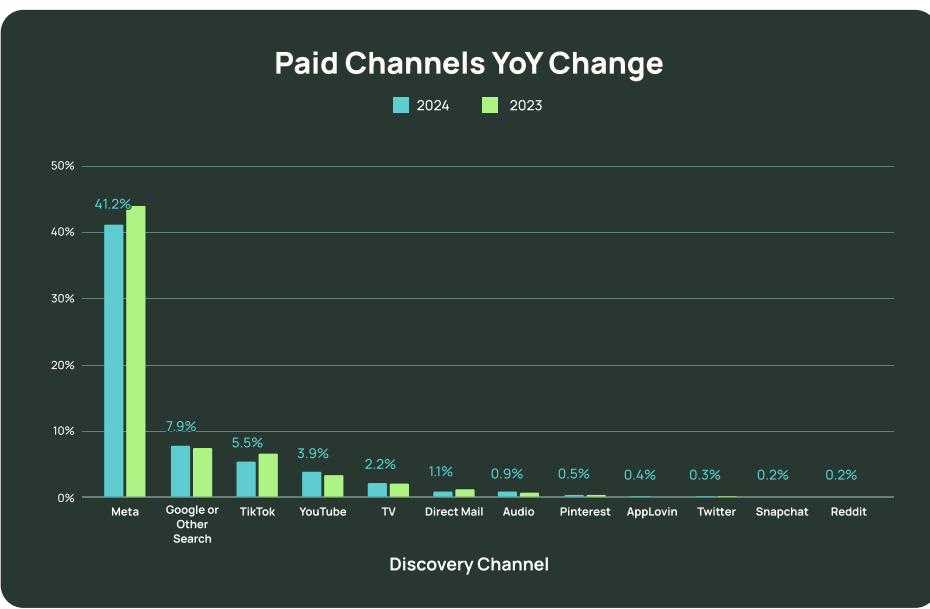
What do you notice?
Meta saw the biggest absolute change, declining from 44% to 41.2% of discovery. TikTok had the greatest percentage decline, dropping from 6.8% to 5.5%, which can be attributed to the launch of TikTok Shops which is where that gap is now being captured.
Despite these next channels making up less than 2% of total discovery, Direct mail, Pinterest, and Twitter all fell year over year. Direct mail dropped 17%, Pinterest fell 13%, and Twitter declined 8%. Notice a trend?
Now, let’s compare this to how organic channel spending has changed year over year:
- Word of Mouth
- Retail
- Influencer
- Blog or Article
- Amazon
- And more.
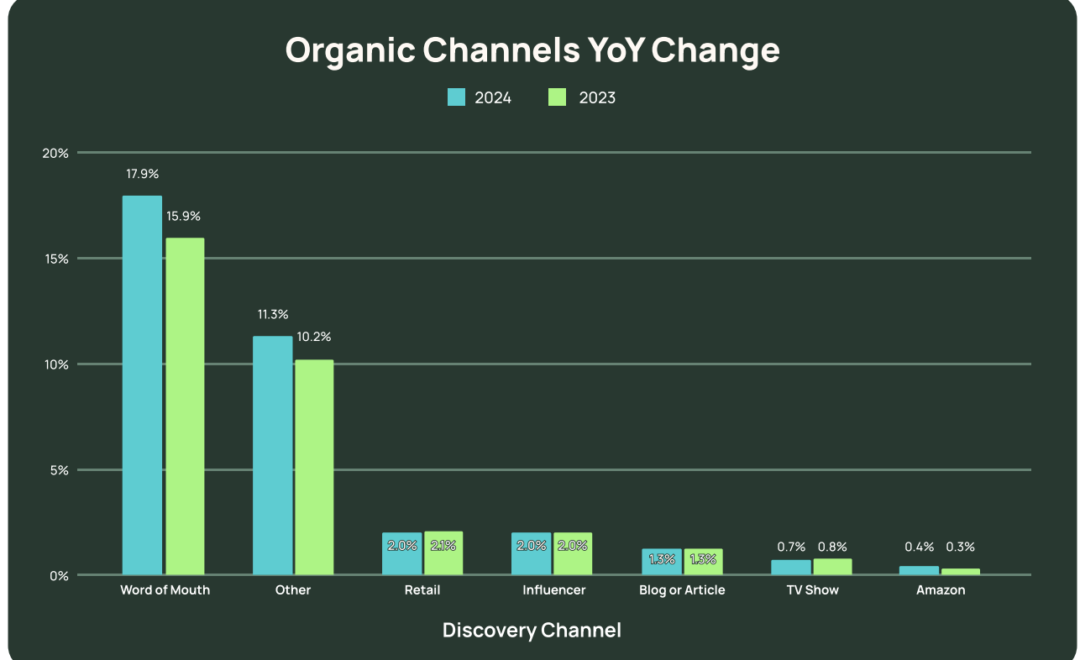
We found that in 2024, Amazon was the biggest positive mover year over year, driving 48% more discovery than in 2023. Amazon is still very small, coming in at less than 0.5% of discovery, but it’s encouraging to see that discovery on Amazon is helping drive purchases on DTC.
Retail discovery saw a slight decline but still came in more than 2%, which is very healthy. Other smaller organic channels like Blogs/Articles and TV Shows saw a decline of 5% and 11% respectively.
Now the ultimate organic channel—Word of Mouth—rose significantly in 2024. Looking at the numbers, we can understand that Organic is King when it comes to brand and product discovery in 2025.
Remember, every age demographic impacts brand discovery
Just as brand discovery channels are changing, so are the ways different demographics find their products. Here’s the breakdown:
Gen Alpha
The new generation of consumers tends to find their products and brands through social media platforms, with 26% of Gen Alpha using social to discover potential purchases. These young digital natives are no strangers to online shopping. To reach this age group, leverage social platforms and digital experiences to get your product out there.
Gen Z
Gen Z discovers new brands through social media ads (32%), TV ads (28%), and search engines (28%). But let’s not forget about our Old Faithful—word-of-mouth. In fact, 26% of Gen Z rely on word-of-mouth recommendations for new product and brand discovery. This means that it’s critical to employ digital channels while also including brand-to-user interaction to get this generation talking.
Millennials
When it comes to this generation with product and brand discovery, 33% of millennials discover via search engines, 31% via social media ads, and 31% via TV ads. Notably, this generation focuses more on expert blog posts than others, with 11% of people finding them valuable. This means to target this generation, your marketing should focus on expertise leadership, authenticity, and genuine brand content.
Gen X
Gen X enjoys a perfect blend of digital and traditional discovery channels with individuals using search engines most often (37%), TV ads (36%) and word-of-mouth recommendations (33%). This generation loves to be brand-loyal, so VIP experiences and promotions are important to connect with this demographic.
Boomers
This age group loves things traditional, using traditional media and engaging with familiar channels is what they do best. For Boomers, TV ads were an answer for 45% of survey respondents, word-of-mouth trailing behind at 39%, and in-store promotions at 31%. To really connect with this age group, focus on print media like magazine ads and direct mail, which is what 37% of respondents said would catch their eye.
Our predictions: What to expect for brand discovery in 2025
TikTok booms
TikTok continues to prosper in 2025. Following the launch of TikTok Shop in 2023, the online video platform just keeps garnering attention—and it’s not stopping this year.
TikTok is experiencing booming growth, despite political pressures, with monthly active users projected to reach 1.6 billion, up from 1 billion monthly active users in 2023. TikTok’s growth is driven by global audiences, with dominant and largest markets in the United States, China, and Indonesia.
This presents a valuable and unmatched opportunity for brand and product discovery, but only if you know how to adapt to TikTok’s engagement style. This means producing short-form branded content to take advantage of the app’s complex algorithm, leveraging influencer and creator-led collaborations, and implementing TikTok Shop’s interactive shopping features.
Still feeling lost? Sign up for our TikTok Playbook for more insight, guidance, and examples on how to win TikTok advertising in 2025.
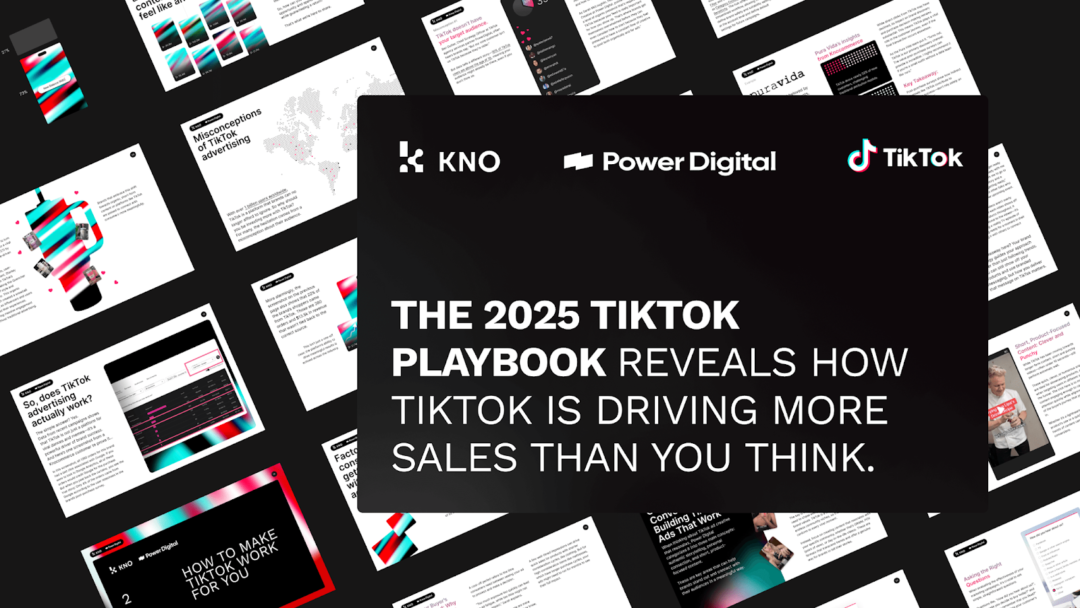
AppLovin’s impact continues to soar
AppLovin is the new mobile advertising platform that had a major influencer moment near the end of 2024. The platform allows you to advertise through mobile game ads, which not only sparks brand visibility but also encourages engagement.
While news on this front has quieted down in recent months, those who tested it were seeing good results due to its 100% Thumb stop rate, meaning rather than social media ads you can scroll by, Applovin ensures viewer engagement for at least a few seconds.
At the end of 2024, Knocommerce data showed that AppLovin is leveraging rising trends, with more consumers finding and buying from brands through mobile game ads.
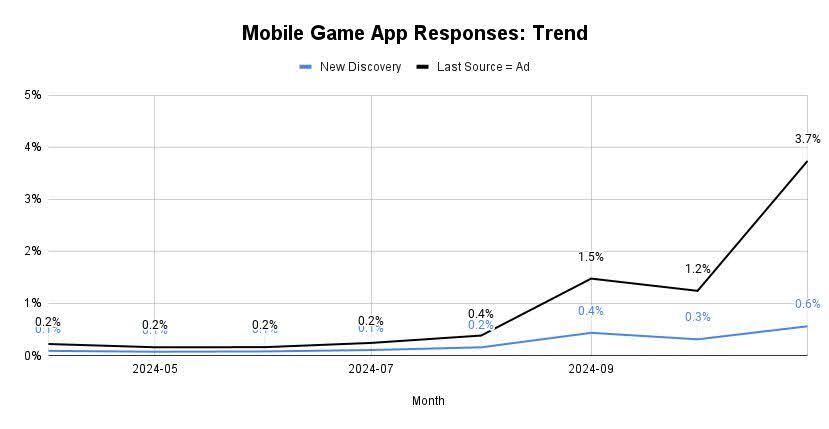
However, just as fast as it began, the hype is already slowing. And there are rumors about how much you have to spend on Meta before you’re even eligible for AppLovin, making it not a platform that’s accessible to all DTC businesses.
Not to mention, the platform’s black box around targeting and delivery transparency still exists, which turns some advertisers off.
Despite these less-than-ideal circumstances, we still believe AppLovin is going to be a power advertising platform in 2025. Especially considering AppLovin just offloaded its mobile games business. And this is kind of a big deal…
They’re literally locking themselves into and doubling down on mobile ad mediation and removing other distractions to their core business. So, we’ll see what happens this year based on these moves.
If you’re testing AppLovin right now and want to track attribution better, we built a template to track the impact of AppLovin through post-purchase surveys. If you’re not on the KNO platform yet, you can sign up for a 7-day free trial here.
Survey says: Smart attribution starts post-purchase
Knowing where your customers come from is half the battle—understanding why they converted is what sets leading brands apart. That’s where post-purchase surveys come in.
Unlike raw transactional data, which only tells you what happened, post-purchase surveys unlock the why behind every purchase. This means instead of guessing which marketing channels are working, you can pinpoint the exact touchpoints that drive conversions and optimize your strategy accordingly.
Here’s why smart brands are making post-purchase surveys a priority in 2025:
- Dial in your marketing attribution. Stop relying on incomplete tracking methods—get direct customer feedback on how they discovered your brand.
- Gaining insights into customer behavior, marketing attribution, conversion rate optimization (CRO) and product development.
- Fine-tune your ad spend. Identify high-performing channels and put your budget where it matters most.
- Refine your messaging. Use customer insights to craft personalized campaigns that actually resonate.
- Drive long-term retention. Learn what keeps customers coming back and turn first-time buyers into loyal fans.
Post-purchase surveys transform your customers from anonymous data points into real people with real motivations. And in an era where data privacy restrictions are making traditional attribution harder than ever, having a direct line to your customers is the ultimate advantage.
Unlock valuable customer insights with Kno’s post-purchase surveys. Start your free trial today and discover the ‘why’ behind every purchase.
LLMs dominate searches, impacting Google’s CPMs
It’s no secret that people are quick to use AI-powered search to look up anything and everything. In 2025, more consumers are using LLMs like ChatGPT to find products and brands, shifting some discovery away from traditional search engines like Google.
At the same time, Google’s CPMs have steadily risen over the years, despite fluctuations in 2024. While ecommerce advertisers pulled back on spending, ROAS largely held steady, likely due to a temporary opening of ad inventory that created more efficient opportunities for other advertisers.
But this dynamic is shifting. Here’s what to expect in 2025:
- CPMs will keep climbing. With more competition and economic pressures, ad costs aren’t slowing down.
- ROAS is likely to soften. Advertisers may see diminishing returns as search behavior continues to evolve.
- More users will move away from traditional search. As LLMs improve, they’ll capture more product discovery, pulling traffic from Google.
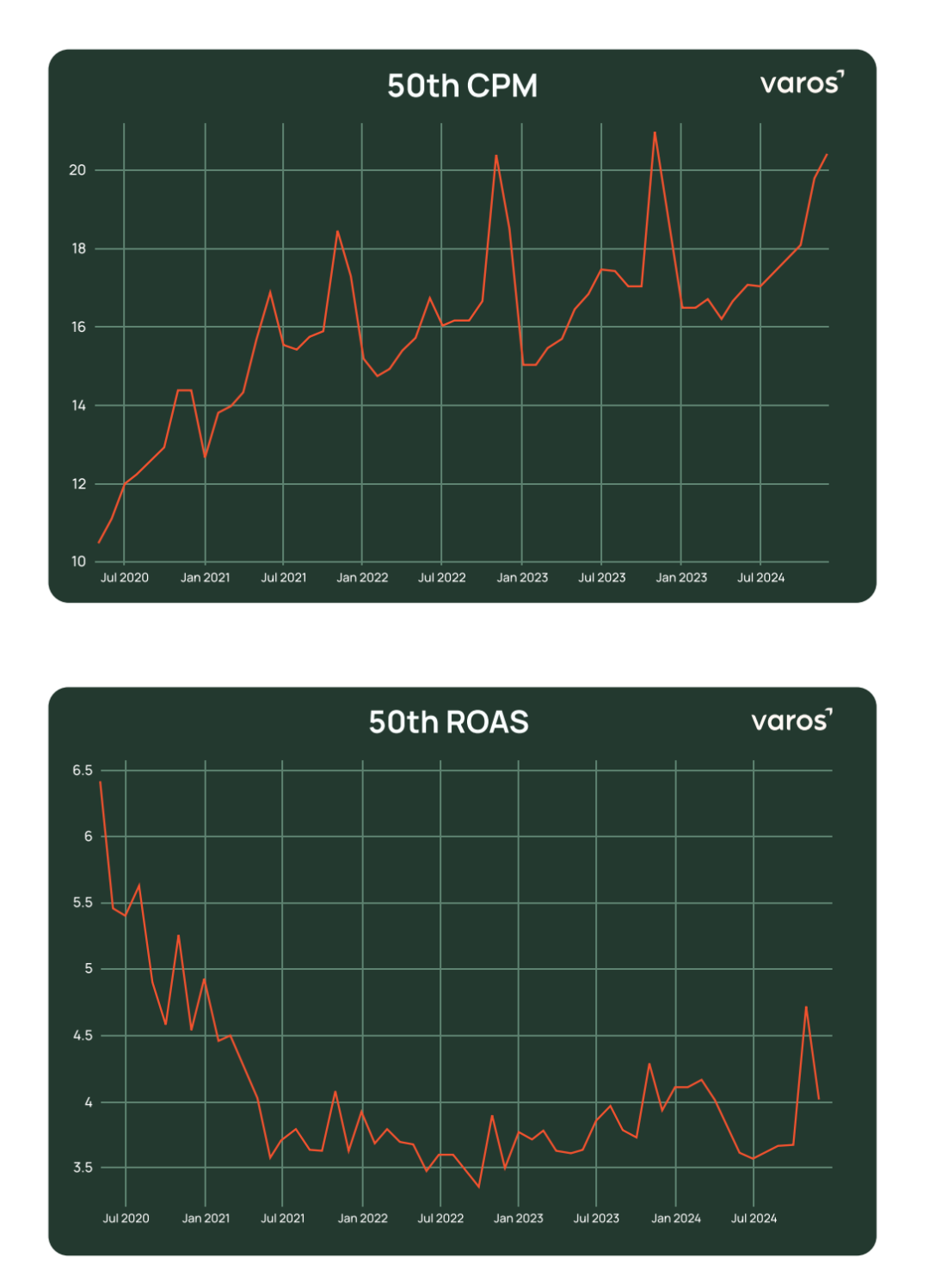
What does this mean for brands?
The current slowdown in Google’s ad performance should be temporary. As Google adapts, rolls out new AI-powered search features, and stabilizes in the face of economic headwinds, expect a rebound in 2026. The brands that stay agile—adjusting their mix between paid search, AI-powered discovery, and organic channels—will be best positioned for long-term success.
Kno how to reach your audience in 2025
The way consumers discover brands is changing fast, and if you want to stay relevant, you need to stay on top of these shifts. From embracing new platforms like TikTok to adapting to evolving trends with tools like AppLovin, the future is all about mixing the right mix of paid and organic channels.
As we look ahead, one thing’s clear: brands that stay flexible and understand where their customers are actually discovering them will thrive. Word-of-mouth, smart advertising, and a deeper focus on real customer insights will make all the difference.
If you’re ready to make sure your brand stays front and center, start by really understanding what’s driving your customer’s choices. Post-purchase surveys are a game-changer when it comes to getting the right data to fine-tune your strategy.
Let’s make sure your brand isn’t just keeping up, but leading the way. Schedule a demo with us today!